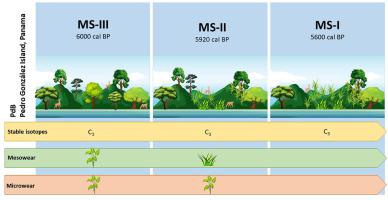Journal of Archaeological Science ( IF 2.8 ) Pub Date : 2022-05-19 , DOI: 10.1016/j.jas.2022.105613 María Fernanda Martínez-Polanco , Florent Rivals , Nawa Sugiyama , Christine A.M. France , Sergio Andrés Castro Méndez , Máximo Jiménez-Acosta , Juan Guillermo Martín , Richard G. Cooke

|
The present study's primary goal is to apply analyses of stable isotopes and tooth micro- and mesowear to the question of dietary change among a mid-Holocene population of small brocket deer (Cervidae: Mazama) in response to anthropogenic alteration of the natural insular vegetation for approximately 450 calendar years (6060-5620 cal yr BP). The brocket deer remains were found in shell-bearing middens on Pedro González in the Pearl Island archipelago. This island is the third largest of many platform or continental islands in Pacific Panama that were periodically affected by rising post-glacial seas during Pleistocene warm periods and became hills in drowned plains during glacial periods, which were extensive on the Pacific side of the isthmus. Our study is based on pre-Columbian Mazama deer remains recovered from excavations in the ancient middens of Pedro González and on modern skeletons of Mazama deer belonging to three United States museum collections. For comparative purposes we added museum specimens of extant white-tailed deer (Odocoileus virginianus) of reduced size from the Florida Keys and Coiba Island (Pacific Panama). Our results show that the diets of 1) present-day white-tailed deer from Coiba and the Florida Keys and 2) the brocket deer (Mazama) still present on San José Island were browsers. On the other hand, as soon as Preceramic people arrived on Pedro Gonzalez ca 6000 cal yr BP, the local brocket deer's diet gradually included more and more abrasive plants in response to changes in vegetation cover related to increasing anthropogenic clearance for cultivation.
中文翻译:

人类对岛屿的生态影响:以太平洋巴拿马珍珠岛群岛佩德罗冈萨雷斯岛上的一只矮鹿(鹿科:Mazama sp.)为例(6.2-5.6 kya)
本研究的主要目标是将稳定同位素和牙齿微磨损和中磨损分析应用到全新世中期小型短尾鹿(鹿科:Mazama)种群的饮食变化问题,以应对天然岛屿植被的人为改变大约 450 个日历年(6060-5620 cal yr BP)。在珍珠岛群岛佩德罗冈萨雷斯 (Pedro González) 的贝壳中发现了小鹿的遗骸。这个岛是巴拿马太平洋许多平台或大陆岛屿中的第三大岛,在更新世温暖时期受到冰后海平面上升的影响,并在冰川时期成为淹没平原的山丘,在地峡的太平洋一侧广泛存在。我们的研究基于前哥伦布时期的Mazama鹿遗骸是从佩德罗·冈萨雷斯 (Pedro González) 古代山丘的发掘中发现的,以及属于美国三个博物馆藏品的现代马扎马鹿骨骼上的遗骸。出于比较目的,我们添加了来自佛罗里达群岛和科伊巴岛(太平洋巴拿马)的缩小尺寸的现存白尾鹿(Odocoileus virginianus )的博物馆标本。我们的研究结果表明,1) 来自 Coiba 和佛罗里达群岛的现代白尾鹿和 2) 斑鹿 ( Mazama) 仍然存在于圣何塞岛上的是浏览器。另一方面,当 Preceramic 人到达 Pedro Gonzalez ca 6000 cal yr BP 时,当地的斑鹿的饮食逐渐包括越来越多的磨蚀性植物,以响应与增加人为耕作间隙相关的植被覆盖变化。



























 京公网安备 11010802027423号
京公网安备 11010802027423号